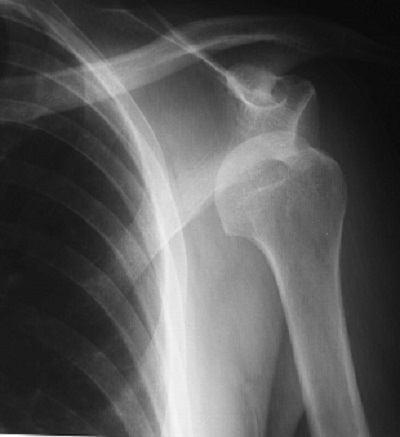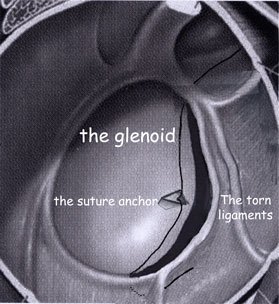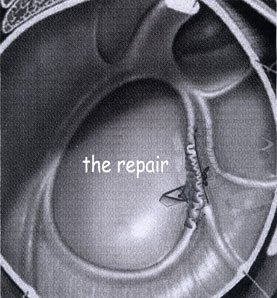Shoulder Instability
Print PdfShoulder Instability–Arthroscopic/Open Stabilisation
Arthroscopic / Open Stabilisation of the Shoulder
Introduction
The shoulder is a ball and socket joint. The socket of the shoulder is like a flat saucer, while the ball is a hemisphere. This arrangement of a shallow socket and a hemishperical ball allows for a large range of movement, but makes the joint prone to instability. To increase the stability of the joint without compromising the movement, the socket is deepened by the attachment of a cartilagenous ring along its circumference called the 'Labrum'.
Support from the ligaments and muscles is essential.
When the shoulder dislocates, the labrum and the ligaments can be torn or stretched and in some cases need to be repaired.

The Operation
The operation is done by 'key hole surgery'; usually through two or three 5mm puncture wounds.The operation involves repairing the over-stretched or torn ligaments deep around the shoulder joint. The repair involves stitching the torn or stretched ligaments back onto its attachment to the socket of the shoulder blade (Glenoid). This is done using tiny anchors with sutures attached to them. The repair should be protected until healing take place (for initial healing - 6 weeks).
If not suitable, the surgeon may perform open stabilisation. (Rare - less than 2%).


General Advice
You will usually be in hospital either for a day or overnight. The operation is performed under general anaesthetic and a nerve block in your neck or upper chest that will make your arm 'dead' for 8-12 hours after surgery. This is for post operative pain relief. After this the shoulder may well be sore and you will be given painkillers to help this. Ice packs may also help reduce pain. Wrap crushed ice or frozen peas in a damp, cold cloth and place on the shoulder for up to 15 minutes.
You will return from theatre wearing a sling. Your arm will remain in a special sling for 6 weeks. This means that you will be unable to use the arm throughout this time and you will be unable to return to work. You will not be allowed to drive for 6-8 weeks after surgery.
You will return from theatre wearing a sling. Your arm will remain in a special sling for 6 weeks. This means that you will be unable to use the arm throughout this time and you will be unable to return to work. You will not be allowed to drive for 6-8 weeks after surgery.
You will be expected to remove the sling for exercises only. Your physiotherapist will advise you of these.
A doctor/physiotherapist will see you prior to discharge and you will be taught exercises to do and given further advice to guide you through your recovery.
The length of time that you will be off work will depend on your job but expect a minimum of 6 weeks.
The wounds:
- Arthroscopic (keyhole) stabilisation: This keyhole operation is usually done through two or three 5mm puncture wounds. There may be no stitches (may be only one absorbable stitch in the front wound) only small sticking plaster strips over the wounds. These should be kept dry until healed. This usually takes 5 to 7 days.
- Open stabilisation: There is an incision at the front of the armpit within the natural skin crease. The stitch is dissolvable but is usually removed at 3 weeks. Keep the wound dry until it is well healed.
Sport / Leisure Activities: Your physiotherapist and surgeon will advise you when it is safe to resume your leisure activities.
However, you will NOT be allowed to return to contact sports before 6 months from surgery.
Complications
As with all surgery there is a risk of some complications. These are rare, but you should be aware of them before your operation. They include:
- Complications relating to the anaesthetic.
- Infection.
- Injury to the nerves or blood vessels around the shoulder.
- Prolonged stiffness and or pain.
- Failure to achieve successful result.
- A further dislocation of the shoulder (less than 5%).
- A need to redo the surgery.
If you require further information please discuss with the doctors either in clinic or on admission.
Exercises
The shoulder must remain immobilised with a sling and a body belt (underneath the clothes) for 3 weeks. At your follow-up appointment the body belt will be removed and you will be allowed to wear the sling on top of your clothes.
You will perform first only elbow, wrist and hand exercises.
You may well be expected to perform the following exercises when you leave hospital. Please check with your physiotherapist before commencing.
- Keep your arm in the sling and move your hand up and down at the wrist.
- With your arm out of the sling bend and straighten the elbow
- With your arm in the sling and the elbow bent at your side, turn the hand to face the ceiling and then the ground.
- With arm in the sling regularly shrug shoulders up and down and circle forwards and backwards
Repeat these exercises four times per day. The number you should perform at each session will be recorded for you by your physiotherapist.
Continue these exercises until otherwise advised by your physiotherapist.
If you require further information please discuss this with the doctors either in clinic or on admission.
